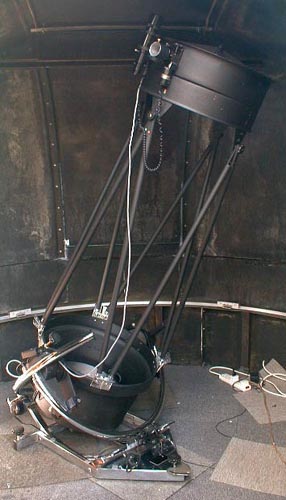
 The combination of the Newtonian reflector optics and open tube is certainly not what most people imagine a
'telescope' to look like (I'd like to have seen Nelson try to hold the NGT up to his blind eye).
The combination of the Newtonian reflector optics and open tube is certainly not what most people imagine a
'telescope' to look like (I'd like to have seen Nelson try to hold the NGT up to his blind eye).
It is not what the NGT looks like that really matters at the end of the day, but how it performs.
| Primary Mirror | 18 inch (457mm) diameter, focal length 80.7inches (2032mm) |
| Mount | Equatorial, split ring |
| Drive | Dual axis drive operated from hand control on wander lead |
| Focusser | SN9 Low profile, motorised SN1889 NGF, low profile motorised Crayford type |
| Secondary mount | Rotating to allow eyepiece access from any position. Three vertical positions to give access to prime focus for photography. |
| Setting circles | SN9 Electronic (DSCmax) accurate to 20 arc minutes in actual use SN1889 Electronic (NGCmax) accurate to 5 arc minutes in actual use |
| Production date | SN9 June 1989 (used until 2004) SN 1889 Jan 2004 (used Jan 2004 - ) |
In average sky conditions from my previous sub-urban location the NGT would show stars to magnitude 15.
From our current rural location it shows stars to magnitude 16.0 on an average night and below 16.5 on transparent nights.
Put another way, on a transparent night, the NGT will show stars more than 10,000 times fainter than can be seen with the naked eye.
 At my former location local obstacles were a real issue and so I made the decision to by a ‘portable’ instrument that I could move
around the garden to avoid the obstructions.
At my former location local obstacles were a real issue and so I made the decision to by a ‘portable’ instrument that I could move
around the garden to avoid the obstructions.
As usual I’m afraid aperture fever got the better of me and I ended up purchasing an instrument which is probably better described as ‘luggable’ rather than ‘portable’.
The nature of the obstructions might have changed (now trees where it was formerly buildings) but the usefulness of an instrument that can be moved around hasn’t. The dobbie still sees regular use, particularly on those rare occasions when I go to a star party or visit astronomically minded friends.
A free tip when you are thinking about buying a portable telescope - make sure it fits in the car first!
This one does - but only just.
| Primary Mirror | 10 inch (254mm) diameter, focal length 45inches (1143mm) |
| Mount | Dobsonian, Alt-az |
| Drive | None |
| Focusser | Low profile, motorised |
| Secondary mount | Conventional, four vane. |
| Setting circles | None |